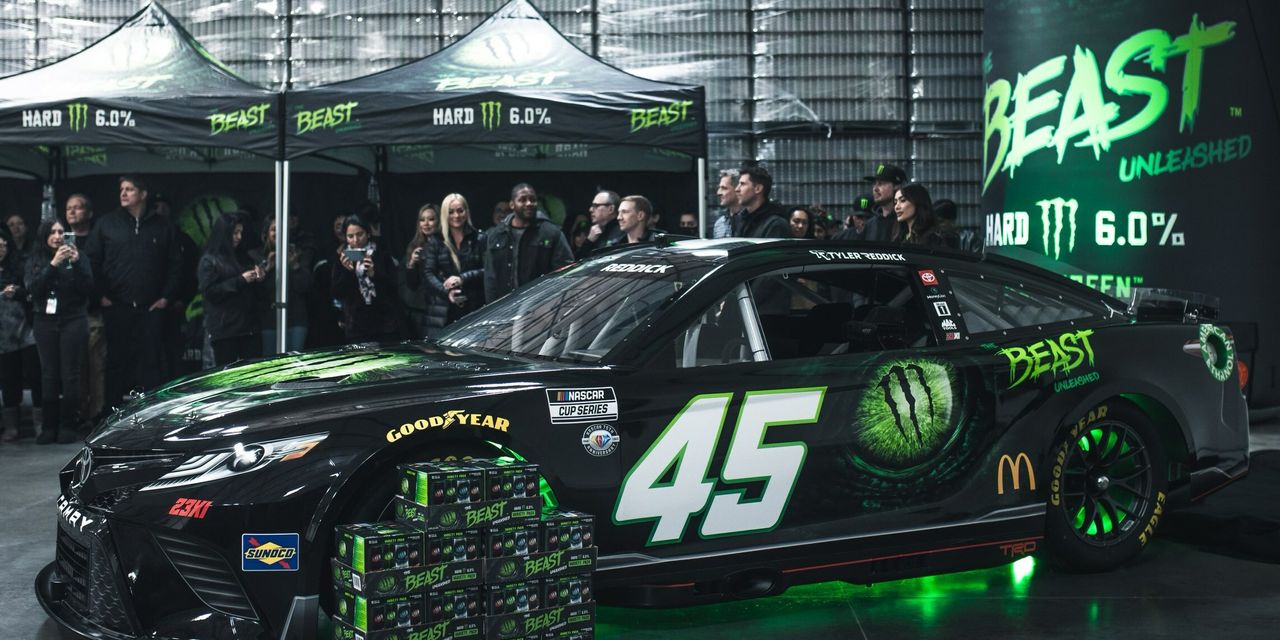Past returns are no guarantee of future ones, but in the case of energy-drink maker
Monster Beverage,
they very well could be. After a recent pause, the stock looks set to resume a 25-year winning streak.
The Corona, Calif.–based Monster (ticker: MNST) has been the market’s version of an unstoppable force over that time. It has outperformed not just beverage makers like
Coca-Cola
(KO),
PepsiCo
(PEP), and
Boston Beer
(SAM), but also tech titans
Apple
(AAPL) and
Microsoft
(MSFT), while on its way to a 58% annual return, the best by a U.S. stock over that period. It’s an amazing feat for a company whose drinks have historically been consumed by male teens and young adults, and taste something like carbonated cough syrup.
Monster’s run was interrupted when a lackluster earnings release caused the stock to fall nearly 5% on Aug. 4. The company’s growth story isn’t over, however. Monster excels at finding untapped niches that can keep sales coming, and these days that means adding alcoholic beverages and energy drinks targeted at women.
Monster should also return to its high-margin ways, which should keep earnings growing at a double-digit clip—and its stock pushing higher.
“Its [second-quarter 2023] results were below expectations, but there is nothing concerning about the business or its near and long-term momentum,” writes Piper Sandler analyst Michael Lavery, who upgraded the stock to Buy on Aug. 6. “We like the brand and company’s positioning.”
Monster, which sports a market value of $60 billion, began life as Hansen Natural, which was bought out of bankruptcy by California Co-Packers, headed by Rodney Sacks and Hilton Schlosberg, in 1990. After seeing the explosive growth of Red Bull energy drinks, the company launched its own, and Monster Beverage was born.
Sacks and Schlosberg, who continue to serve as co-CEOs, were eager to market their drink as a lifestyle, rather than just a beverage product, explains RBC analyst Nik Modi, and have largely succeeded thanks to longstanding advertising deals with Monster Jam truck shows, UFC mixed martial arts, Nascar, and Premier League soccer. “It’s the next global megabrand,” Modi says. “That’s truly the stock story going forward.”
It isn’t the only story. Though energy drinks have been around for a while, they are still expected to grow at an 8.3% annual clip, from $86 billion in 2021 to $176 billion in 2030, according to Grand View Research, compared with soft-drink growth of 4.7%. Early growth came at the expense of carbonated beverages, but it has continued by offering other, healthier versions of energy drinks to boost market share. “The energy-drink category is sourcing growth from…carbonated soft drinks…as it begins to expand with innovation, with zero-sugar products and performance energy drinks,” says Goldman Sachs analyst Bonnie Herzog.
Despite Monster’s recent disappointment—it reported uninspiring earnings of 39 cents a share on sales of $1.86 billion versus forecasts for 39 cents and $1.87 billion—its outlook remains as fizzy as ever. Monster’s sales should grow by 14% in 2023 and 12% in 2024, consistent with its historical rate of growth, according to FactSet, as it continues to push into new segments.
The company said at its June investor conference that it has been pleased with the launch of its Monster Energy Zero Sugar drink, which hit the market in the first quarter of 2023; and it has just launched a hard seltzer, The Beast Unleashed, which management said on its second-quarter earnings call had already become one of the top-selling new “beers” this year.
See All the Stocks We’re Bullish—and Bearish—On
The company also purchased CanArchy Craft Brewery, a hard-seltzer company, for $330 million in January of 2022. Analysts predict $324 million in alcohol revenue next year, or 4% of the total sales forecast of $7.99 billion, a number Herzog calls “conservative” because she expects the company to become a serious competitor in the alcohol market.
Monster is looking to new markets for growth. It’s pushing its drinks into Latin America, which could grow 20% annually, and Europe, the Middle East, and Africa, where a 10% growth rate is possible, writes HSBC analyst Carlos Laboy. The company is also looking to expand outside its typically male customer by purchasing Bang Energy—which has a largely female consumer base—out of bankruptcy, says Laboy, who initiated Monster stock with a Buy rating on Aug. 14, and assigned it a $72 price target, up 26% from a recent $57.32.
“Monster has skewed heavily to male consumers, but we now see the firm developing its own new labels and acquiring brands that should support recruitment of female consumers in Monster’s largest market, the U.S.,” Laboy writes.
The next leg up for the stock might be driven by improving margins. Following the pandemic, Monster elected not to raise prices, even though costs rose by nearly 30% in 2021 and 2022, causing gross margins to fall from 60% in 2019 to 50% in 2022. Margins should start to improve as shipping costs and aluminum prices decline, and the company lifts prices, which it started to do in April. That should help earnings grow 37% to $1.54 in 2023, and 17% to $1.80 in 2024.
At 33.7 times 12-month forward earnings, Monster doesn’t look cheap compared with its five-year average of 30.9 times or the
S&P 500,
which trades at 18.7 times. But that doesn’t reflect its earnings growth, which has been consistently strong. The stock, though, trades with a price/earnings divided by earnings-per-share growth, or PEG, ratio of 1.8 times. That’s below its five-year average of 2.5 times, and a far more reasonable valuation.
At that price, Monster stock should provide a nice jolt to any portfolio.
Write to Jacob Sonenshine at [email protected]
Read the full article here



